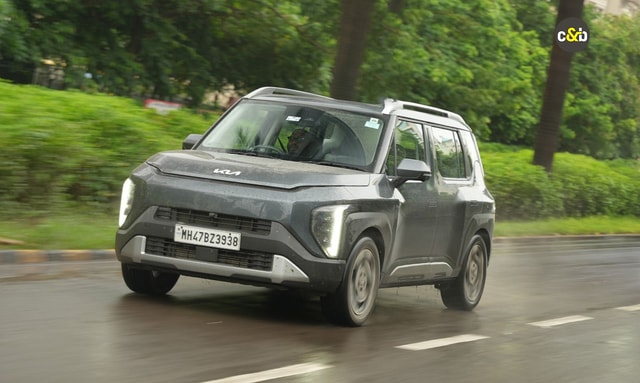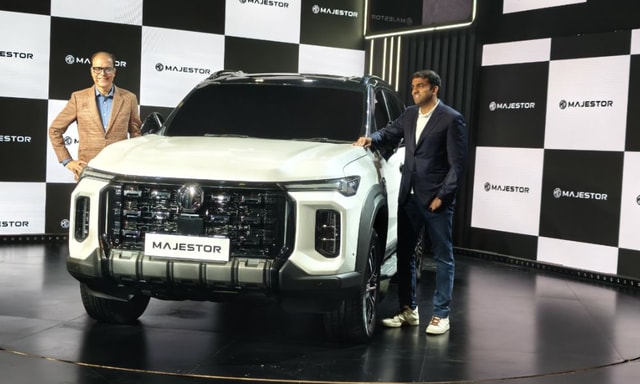Mercedes-Benz Aims To Reduce Its Carbon Footprint By 50 Per Cent Till 2030

- The aim is to achieve up to 50% share of PHEV and BEVs by 2025.
- Mercedes-Benz will roll out solar and wind power at its plants.
- Would cover more than 70% of its energy needs through renewable energy.
At its first digital ESG (Environment, Social and Governance) Conference for investors and analysts, Mercedes-Benz announced measures aimed at cutting CO2 emissions to at least half per passenger car over the lifecycle by the end of this decade compared to 2020 levels. To achieve this goal, Mercedes-Benz will electrify its vehicle fleet, charging with green energy, improving battery technology, and extensively use recycled materials and renewable energy in production. Mercedes-Benz plans to cover more than 70 per cent of its energy needs through renewable energy by 2030 by rolling out solar and wind power at its plants.
undefinedBy 2030, we aim to reduce our CO2 emissions by more than 50 per cent per passenger car over the lifecycle, compared with 2020. The interim target is an important milestone on the path to achieving carbon neutrality by 2039.#Sustainability #ambition2039
— Mercedes-Benz (@MercedesBenz) April 11, 2022
Also Read: Mercedes-Benz Bets On India's Nouveau Riche To Drive Luxury Car Sales
Ola Kallenius, Chairman of the Board of Management of Mercedes-Benz Group AG said, “The desire for individual mobility keeps growing. Our mission is to meet this need in a sustainable way. Mercedes-Benz has a clear roadmap on how to become carbon neutral. By 2030, we want to reach the halfway mark. To make faster progress in protecting the climate we need maximum dedication and more collaboration among governments, companies, and society.”

The aim is to achieve up to 50 percent share of plug-in hybrid and BEVs by 2025 on the way toward going all-electric by 2030 wherever market conditions allow.
The aim is to achieve up to 50 percent share of plug-in hybrid and BEVs by 2025 on the way toward going all-electric by 2030 wherever market conditions allow. The portfolio already includes six, and soon nine, all-electric models. At present, Mercedes-Benz has the EQA, the EQB, the EQC, the EQS, the EQE 350+ as well as the EQV in its EQ range. Models such as the EQS SUV, the EQE SUV, and the EQT, will soon join the range. But it is the production of batteries for its EVs that is the biggest contributor.
undefinedOur #ESG Conference 2022 showed: sustainable development is a guiding principle for Mercedes-Benz, generating environmental, social and governmental added value for our stakeholders and society as a whole. That's why we have a holistic ESG concept.
— Mercedes-Benz (@MercedesBenz) April 12, 2022
Also Read: Mercedes-Benz Accelerates In-House Software Push With New Tech Centre
And so, Mercedes-Benz would transition to CO2 neutral cell production, which would result in cutting down emissions by almost 20 per cent. Moreover, strategic partnerships are formed to develop highly advanced and competitive cell technologies. At the same time, Mercedes-Benz expects to be able to use LFP batteries in its series-production vehicles. These batteries have a completely cobalt-free cathode. Together with research partners, the company is also working on solid-state batteries. To keep control of the battery lifecycle in-house, the company is starting a CO2-neutral recycling factory in Kuppenheim, Germany, to recycle end-of-life electric vehicle batteries using a new hydrometallurgical technique which increases the recycling rate to 96 per cent.
Also Read: Mercedes-Benz EQS SUV Teased; Global Debut On April 19
Another step that the German carmaker announced is setting up a green steel supply chain to expand its use of low-CO2 and zero‑CO2 steel. For this, the company will work closely with Swedish start-up H2 Green Steel (H2GS), with the aim of introducing green steel in several production models by as early as 2025.
Latest News
 Jaiveer Mehra | Jan 17, 20262026 Tata Punch Facelift Price, Variants ExplainedUpdated Punch is available in 8 trim levels with naturally aspirated petrol, CNG and turbo-petrol engine options.3 mins read
Jaiveer Mehra | Jan 17, 20262026 Tata Punch Facelift Price, Variants ExplainedUpdated Punch is available in 8 trim levels with naturally aspirated petrol, CNG and turbo-petrol engine options.3 mins read car&bike Team | Jan 17, 2026Skoda Kushaq Facelift Teased Ahead of Launch In Coming WeeksMid-lifecycle update to bring with it styling updates as well as new features inside the cabin.1 min read
car&bike Team | Jan 17, 2026Skoda Kushaq Facelift Teased Ahead of Launch In Coming WeeksMid-lifecycle update to bring with it styling updates as well as new features inside the cabin.1 min read car&bike Team | Jan 16, 2026Pierer Mobility AG Rebranded as Bajaj Mobility AG Following KTM TakeoverThis marks a major shift in ownership and strategic direction in the global motorcycle industry.1 min read
car&bike Team | Jan 16, 2026Pierer Mobility AG Rebranded as Bajaj Mobility AG Following KTM TakeoverThis marks a major shift in ownership and strategic direction in the global motorcycle industry.1 min read Seshan Vijayraghvan | Jan 16, 2026Kia Syros Variant Line-Up Expanded With HTK (EX) Trim; Prices Start At Rs. 9.89 LakhPositioned between the HTK (O) and HTK+ trims, the new variant will be offered in both petrol and diesel options.2 mins read
Seshan Vijayraghvan | Jan 16, 2026Kia Syros Variant Line-Up Expanded With HTK (EX) Trim; Prices Start At Rs. 9.89 LakhPositioned between the HTK (O) and HTK+ trims, the new variant will be offered in both petrol and diesel options.2 mins read car&bike Team | Jan 16, 2026MG Majestor India Launch On February 12Unveiled in India at the 2025 Bharat Mobility Expo, the Majestor is expected to be positioned as a more premium alternative to the Gloster.1 min read
car&bike Team | Jan 16, 2026MG Majestor India Launch On February 12Unveiled in India at the 2025 Bharat Mobility Expo, the Majestor is expected to be positioned as a more premium alternative to the Gloster.1 min read Jaiveer Mehra | Jan 15, 2026Kia Carens Clavis Gets New Sunroof-Equipped HTE(EX) Trim; Prices Start From Rs 12.55 LakhNew lower mid-spec trim is positioned between the HTE(O) and HTK variants and gets some additional features.1 min read
Jaiveer Mehra | Jan 15, 2026Kia Carens Clavis Gets New Sunroof-Equipped HTE(EX) Trim; Prices Start From Rs 12.55 LakhNew lower mid-spec trim is positioned between the HTE(O) and HTK variants and gets some additional features.1 min read
 Amaan Ahmed | Jan 17, 2026Bajaj Chetak C25 First Ride Review: Basic, Likeable E-Scooter For First-Time RidersThe Chetak C25, in quite a few ways, is poles apart from the larger and more powerful 30 and 35 Series models, but in its mannerisms, it is very much a Chetak.8 mins read
Amaan Ahmed | Jan 17, 2026Bajaj Chetak C25 First Ride Review: Basic, Likeable E-Scooter For First-Time RidersThe Chetak C25, in quite a few ways, is poles apart from the larger and more powerful 30 and 35 Series models, but in its mannerisms, it is very much a Chetak.8 mins read Bilal Firfiray | Jan 9, 2026Toyota Urban Cruiser Hyryder: 10,000 km Long-Term ReviewAfter spending over three months and 10,000 km with the Toyota Urban Cruiser Hyryder Hybrid, we were impressed by its real-world mileage, seamless hybrid, practical comfort, and Toyota reliability. Is it the best C-SUV then?5 mins read
Bilal Firfiray | Jan 9, 2026Toyota Urban Cruiser Hyryder: 10,000 km Long-Term ReviewAfter spending over three months and 10,000 km with the Toyota Urban Cruiser Hyryder Hybrid, we were impressed by its real-world mileage, seamless hybrid, practical comfort, and Toyota reliability. Is it the best C-SUV then?5 mins read Seshan Vijayraghvan | Jan 8, 20262026 Mahindra XUV 7XO Review: Big On Tech, Bigger On ComfortThe new Mahindra XUV 7XO is flashier, feature packed, and comes with more advanced tech. But are the changes just incremental or actually substantial?1 min read
Seshan Vijayraghvan | Jan 8, 20262026 Mahindra XUV 7XO Review: Big On Tech, Bigger On ComfortThe new Mahindra XUV 7XO is flashier, feature packed, and comes with more advanced tech. But are the changes just incremental or actually substantial?1 min read Preetam Bora | Jan 10, 2026Simple One Gen 2 First Ride Review: 265 km Claimed Range!The Gen 2 model of Simple Energy’s first electric scooter gets a fair few updates, including new features, tech, more range and lighter weight. We spent a couple of hours with the Simple One Gen 2 to find out if it manages to impress.6 mins read
Preetam Bora | Jan 10, 2026Simple One Gen 2 First Ride Review: 265 km Claimed Range!The Gen 2 model of Simple Energy’s first electric scooter gets a fair few updates, including new features, tech, more range and lighter weight. We spent a couple of hours with the Simple One Gen 2 to find out if it manages to impress.6 mins read Amaan Ahmed | Jan 3, 2026VLF Mobster 135 300 KM Review: Fun But FlawedA 125 cc scooter with Italian design and Chinese genes is a rare combination, and while some may be tempted to dismiss it because of its origins, the VLF Mobster shows 125s can also be exciting – but not without compromises.11 mins read
Amaan Ahmed | Jan 3, 2026VLF Mobster 135 300 KM Review: Fun But FlawedA 125 cc scooter with Italian design and Chinese genes is a rare combination, and while some may be tempted to dismiss it because of its origins, the VLF Mobster shows 125s can also be exciting – but not without compromises.11 mins read



































































































































